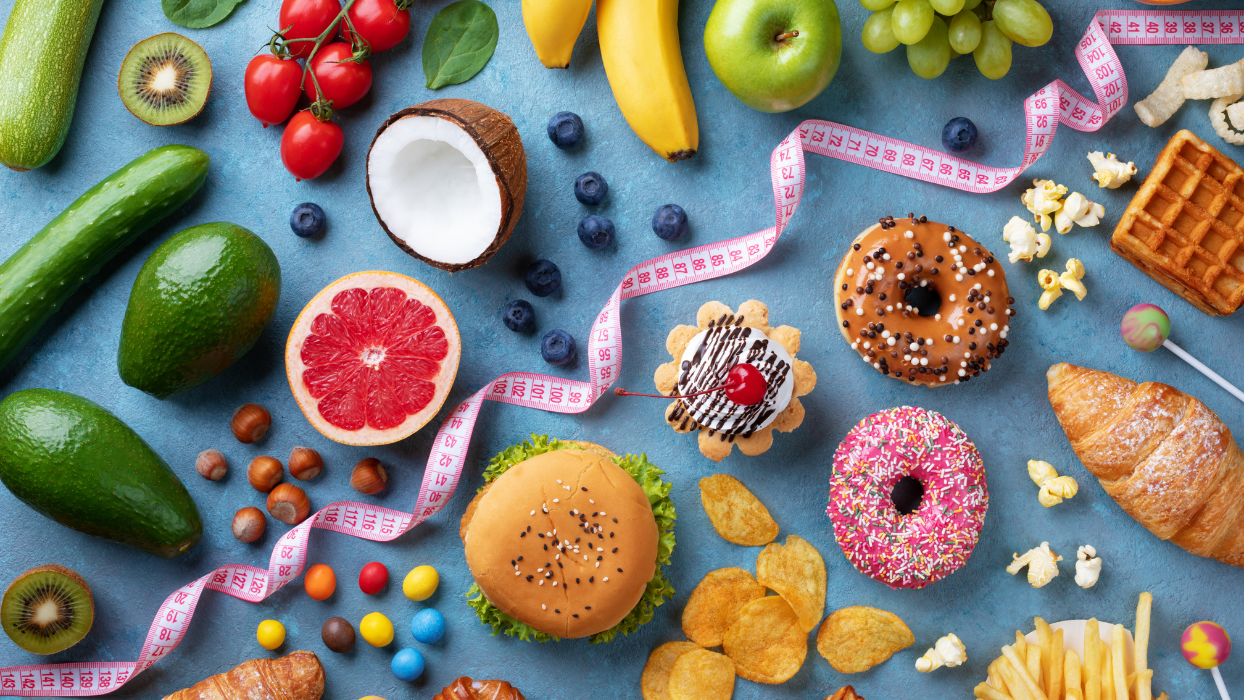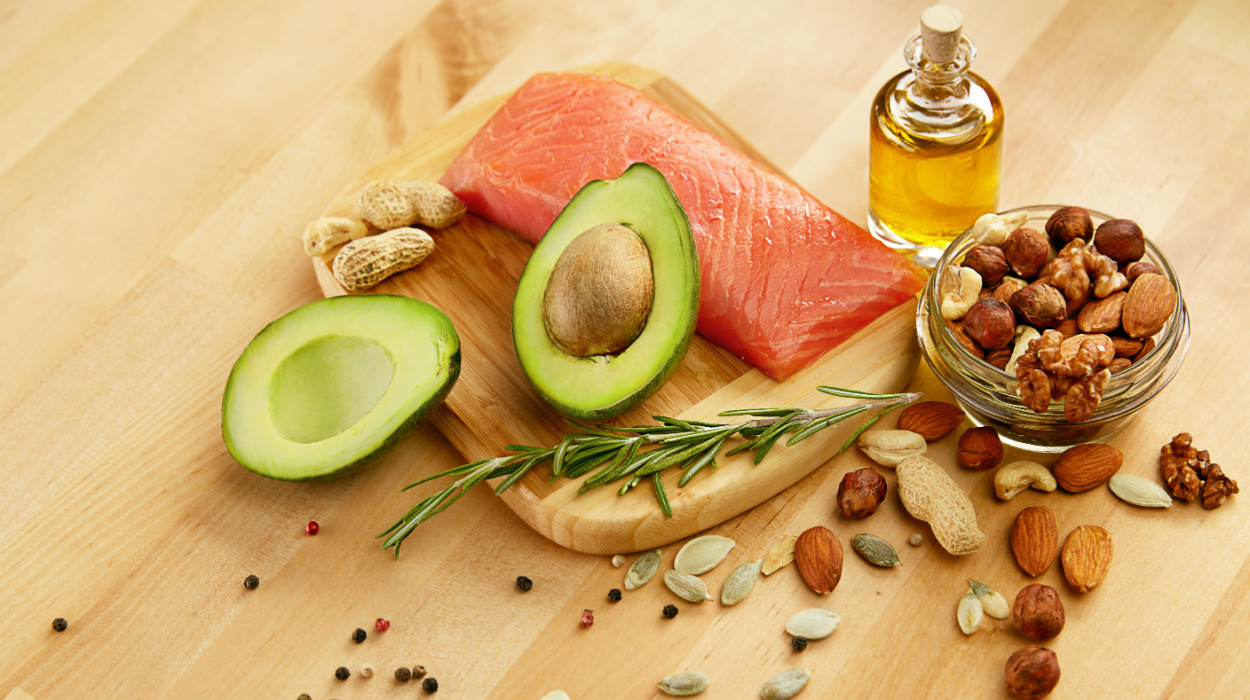Contrary to popular belief, incorporating adequate amounts of healthy fats in your diet can support weight loss. In fact, the body requires a certain amount of dietary fat[1] for the absorption of nutrients and proper cellular function.
So, if you’re wondering how many grams of fat per day to lose weight, this article answers your question and more. Let’s dive into the different types of fats, recommended dietary amounts, healthy high-fat foods, and low-fat diets for losing weight.
How Many Grams Of Fat A Day To Lose Weight?
The number of grams of fat per day to lose weight depends on your current body weight and goals. A certain amount of dietary fat is necessary to maintain optimal functioning. However, lowering your fat intake may translate into eating fewer calories, supporting healthy weight loss.
How Much Fat Should You Eat A Day To Lose Weight?

Fats support brain function,[2] cell structure, and more. Yet, it is recommended to be cautious with some types of fats.
For example, the 2020-2025 Dietary Recommendations for Americans[3] advise having no more than 10% of total daily calories from saturated fats. This includes butter, cheeses, sausages, bacon, and more.
Before you start your weight loss journey, measure your weight at different times every day for a week. These measurements take into account normal variation in your weight due to water weight and current diet. The average of these measurements will more accurately reflect your current weight.
Choosing a low-fat diet may contribute to these weight loss efforts by reducing total daily calorie intake. Yet, evidence indicates that eating low-fat foods is not superior when compared to other weight loss[4] interventions. Nevertheless, it can still be an effective solution to losing weight.
Overall, weight loss requires an energy deficit,[4] which can be obtained by cutting back on fats. Consider that fat has 9 kcal/gram while protein and carbohydrate only have 4 kcal/gram. So fat has more than double the calories of protein and carbs.
Yet, depending on the individual and their lifestyle, other diet plans aside from avoiding a diet high in fat may be easier for adherence and long-term weight loss.
When it comes to sustainable weight loss, other factors may also play a part, such as fiber intake and how much cardio you do. Many also recommend drinking water, specifically before a meal, to lose weight.
Different Types Of Fat
The four main types of fat include monounsaturated and polyunsaturated fats, saturated fats, and trans fats. Below, we take a closer look at each of these.
Monounsaturated Fats
Monounsaturated fats,[5] also called MUFAs, consist of one double bond. The primary type of MUFAs found in the modern Western diet is oleic acid, such as in vegetable oil.
Eating a sufficient amount of these types of fats is associated with various benefits.[5] For example, adequate MUFA consumption may reduce metabolic risk factors, maintain insulin sensitivity, and even improve cardiovascular health.
Polyunsaturated Fats
Polyunsaturated fats,[6] also called PUFAs, contain multiple double-carbon bonds. These types of fats include omega-3s and omega-6s. Omega-3 and omega-6 fatty acids are essential fatty acids, meaning your body cannot make them, and you must get them from food.
Surprisingly, omega-3s[7] are often recommended for those with coronary heart disease due to their cardiovascular benefits. Yet, the balance between omega-3s and omega-6s appears to be a fine line.
The relationship between omega-3s and omega-6s[8] isn’t fully understood. However, it is suggested that high omega-6s could inhibit the anti-inflammatory nature of omega-3s. Thus, it’s important to ensure your diet includes both of these types of polyunsaturated fats.
Foods rich in omega-3s and omega-6s[9] include pumpkin seeds, walnuts, sunflower seeds, fatty fish, and flaxseeds.
Saturated Fats
Saturated fats[10] contain zero double bonds. Contrary to popular belief, studies show that saturated fats, like butter[11] or dairy fat, have a small or neutral impact on cardiovascular disease, diabetes, and mortality.
It’s also recommended to have some of your fat intake come from saturated fats but no more than 10% of your total calories.
Trans Fats
Trans fats[12] result from the hydrogenation or partial hydrogenation of unsaturated fats, which is a process used to extend food shelf life. Unfortunately, trans fat is thought to have negative repercussions on human health, including increasing the risk of cardiovascular disease. As of June 18, 2018, manufacturers can no longer add[13] partially hydrogenated oil to foods.
This man-made fat is found in foods like margarine, spreads, and crackers. Limiting or eliminating this fat type may positively impact heart health.
Recommended Daily Fat Intake
So, how much fat per day should you consume? How many grams of fat a day to lose weight is necessary?
The World Health Organization suggests most adults should limit their fat intake[14] to less than 30% of their total calorie intake. These recommendations further advise that less than 10% of total energy intake should come from saturated fats, and less than 1% should come from trans fats.
For example, if you consume 2000 calories daily, 600 of your daily calories should come from fat. No more than 200 calories should come from saturated fats, and no more than 20 calories should come from trans fats. If you take 600 kcals divided by 9 kcal/gram, you get 67 grams of fat daily.
Healthy High-Fat Foods

With high amounts of processed and pre-packaged food items, dietary fat is easy to come by. Yet, the best type of fat comes from whole food sources. Some great options include:
- Avocado. This fruit has a superfood status for multiple reasons, one being it’s a healthy source of monounsaturated fat. Yet, be careful about serving size here. It’s easy to go overboard with avocados, and most serving size recommendations indicate about one-third of an avocado per day is one serving.
- Fatty fish. These include salmon, mackerel, sardines, and herring. Fish isn’t just a great source of dietary fat but also a wonderful source of healthy protein.
- Olive oil. Olive oil[15] contains oleic acid, a monounsaturated fat that may help lower inflammation.
- Nuts. Healthy nuts include walnuts, almonds, and macadamia nuts. Similar to other fatty foods, portion size is important here, especially if you’re trying to lose weight.
- Dark chocolate. Dark chocolate offers a nutritious and healthy go-to if you have a sweet tooth.
- Eggs. Eggs[16] are a very nutritionally dense food, containing plenty of healthy fats.
In contrast, processed, fried, or sauteed foods, and pre-packaged food items are more likely to contain trans fats. If you’re wondering how to get rid of a hormonal belly, eliminating or limiting these items is recommended. Alternatively, you could also keep these as a treat to enjoy in moderation or on special occasions.
Low-Fat Diets For Losing Weight
Ultimately, a low-fat diet can support weight loss by cutting calories. This is because fat is higher in calories than protein or carbs. So, what should you consider when following a low-fat diet?
- Eat mostly plant-derived foods alongside lean meats.
- Trim the visible fat off meat and take the skin off poultry before eating.
- Refrigerate gravies or stews and remove the fat that rises to the top.
- Bake or grill meats on racks that allow the fat to drip down.
- Swap out butter or dairy-based sauces for lemon juice or spices.
- Opt for low-fat yogurt and other dairy products.
Additionally, ensure you don’t entirely eliminate fats from your diet, as this can create nutrient-deficiency-related health issues. It can help to track your food intake to determine how many calories are coming from fat.
You may also want to reconsider eating fried or sauteed foods, especially when eating out and when you can’t control the amount of oil or fats added.
Lastly, if you’re wondering how to lose weight fast without exercise, reducing your fat intake might help as it reduces calories consumed. Yet, it’s important to not fully eliminate this food group entirely.
Conclusion
It’s entirely possible to lose weight and eat fat. However, determining the number of grams of fat per day to lose weight depends on each individual and their specific goal.
Prioritizing healthy fats, such as monounsaturated fats and polyunsaturated fats, may benefit your overall health throughout your weight loss journey. When selecting healthy fat foods, portion size is further important to ensure you don’t go over your total daily calories.
Frequently Asked Questions
This depends on the individual. For someone following a 1500-calorie diet, this is a suitable amount of fats per day.
This depends on your current weight and weight loss goals. At the same time, losing belly fat comes down to total weight loss, which is dependent on a caloric deficit.
There is no minimum fat requirement. However, it’s important to remember that dietary fat is necessary for normal body functioning and the absorption of certain nutrients.
Some healthy high-fat food options include avocado, fatty fish, dark chocolate, eggs, olive oil, and nuts.
 Evidence Based
Evidence Based
